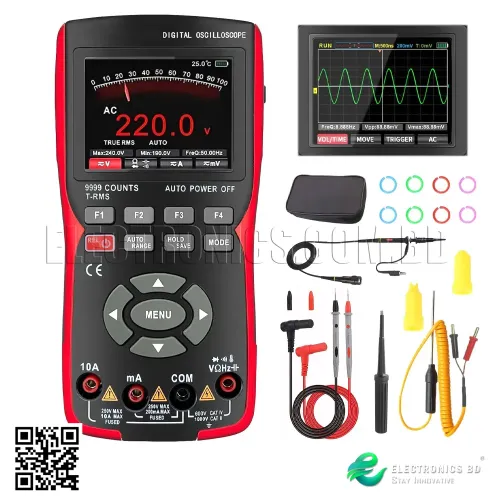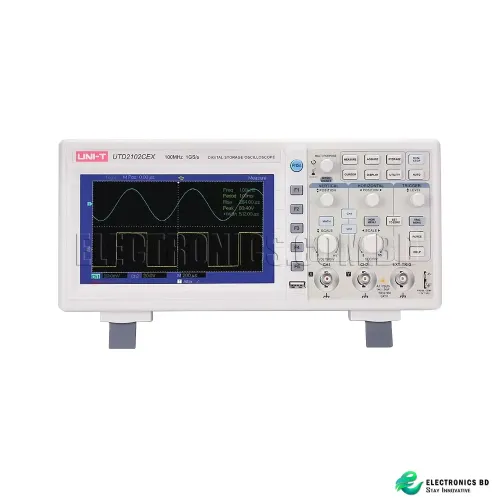- 3D printers & CNC
- Accessories
- Active Components
- All Departments
- CNC Accessories
- Electrical Accessories & IOT
- Latest
- Oscilloscope
- Passive Components
- Projects
- SMD Components
- Socket, Port & Jacks
- Sound Systems
- Drones & RC Hobby
- Sale
Your shopping cart is empty!
- RP2040 microcontroller chip designed by Raspberry Pi in the United Kingdom
- Dual-core ARM Cortex M0+ processor, flexible clock running up to 133 MHz
- 264kB of SRAM, and 2MB of onboard Flash memory
- Infineon CYW43439 wireless chip
- IEEE 802.11 b/g/n wireless LAN
- Bluetooth 5.2 (not software supported at launch)
- WPA3
- SoftAP (up to 4 clients)
- Onboard antenna licenced from ABRACON (connected via SPI to the RP2040)
- Castellated module allows soldering directly to carrier boards
- USB 1.1 Host and Device support
- Low-power sleep and dormant modes
- Drag & drop programming using mass storage over USB
- 26 multi-function GPIO pins
- 2×SPI, 2×I2C, 2×UART, 3×12-bit ADC, 16×controllable PWM channels
- Real-time clock (RTC)
- Temperature sensor
- Accelerated floating-point libraries on-chip
- 8×Programmable IO (PIO) state machines for custom peripheral support
- Dimensions (WxLxH): Pico W: 21mm x 51.3mm x 3.9mm
Product Description
What is the Raspberry Pi Pico W ?
The Raspberry Pi Pico W is a microcontroller board designed by Raspberry Pi in the United Kingdom, featuring the RP2040 microcontroller chip. This board is equipped with a dual-core ARM Cortex M0+ processor, offering flexible clock speeds of up to 133 MHz. It boasts 264kB of SRAM and 2MB of onboard Flash memory, providing ample space for storing programs and data.

In addition to its powerful microcontroller, the Pico W includes an Infineon CYW43439 wireless chip, enabling IEEE 802.11 b/g/n wireless LAN connectivity. While Bluetooth 5.2 is supported by the hardware, it may not be fully enabled in software at launch. The Pico W also supports WPA3 security protocols and SoftAP functionality, allowing up to four clients to connect simultaneously.
Featuring an onboard antenna licensed from ABRACON and connected via SPI to the RP2040, the Pico W offers reliable wireless communication. Its castellated module design allows for easy soldering directly onto carrier boards, making it suitable for integration into various projects.
Other notable features of the Raspberry Pi Pico W include USB 1.1 Host and Device support, low-power sleep and dormant modes for energy efficiency, and drag-and-drop programming using mass storage over USB. It offers 26 multi-function GPIO pins, along with 2×SPI, 2×I2C, 2×UART, and 3×12-bit ADC interfaces, providing ample connectivity options for interfacing with external sensors and peripherals.
With built-in features such as a real-time clock (RTC), temperature sensor, and accelerated floating-point libraries, the Raspberry Pi Pico W offers versatility and performance for a wide range of applications. Its 8×Programmable IO (PIO) state machines further enhance its capabilities, allowing for custom peripheral support. Compact in size, the Pico W measures 21mm x 51.3mm x 3.9mm, making it suitable for compact and space-constrained projects.
Features:

RP2040 Microcontroller Chip: Designed by Raspberry Pi, the RP2040 chip is at the heart of the Pico W, featuring a dual-core ARM Cortex M0+ processor capable of flexible clock speeds up to 133 MHz.
Wireless Connectivity: Equipped with an Infineon CYW43439 wireless chip, the Pico W supports IEEE 802.11 b/g/n wireless LAN connectivity, allowing for wireless communication with other devices and networks.
Bluetooth Support: While the hardware supports Bluetooth 5.2, software support may vary at launch. This feature enables wireless communication with Bluetooth-enabled devices.
Onboard Antenna: The Pico W includes an onboard antenna licensed from ABRACON, connected via SPI to the RP2040, ensuring reliable wireless communication.
Flash Memory and SRAM: With 2MB of onboard Flash memory and 264kB of SRAM, the Pico W provides ample storage for programs and data, allowing for versatile and complex projects.
USB 1.1 Host and Device Support: The Pico W supports USB 1.1 Host and Device functionality, enabling easy connectivity and communication with other USB devices.
Low-Power Modes: Featuring low-power sleep and dormant modes, the Pico W maximizes energy efficiency, making it suitable for battery-powered applications and IoT projects.
GPIO Pins and Interfaces: The Pico W offers 26 multi-function GPIO pins, along with 2×SPI, 2×I2C, 2×UART, and 3×12-bit ADC interfaces, providing extensive connectivity options for interfacing with external sensors and peripherals.
Real-Time Clock (RTC): The onboard real-time clock allows for accurate timekeeping, useful for applications that require scheduling or time-sensitive operations.
Temperature Sensor: Included on the board is a temperature sensor, enabling temperature monitoring and control in various projects.
Compact Size: Measuring just 21mm x 51.3mm x 3.9mm, the Pico W is compact and lightweight, making it suitable for space-constrained projects and applications.
How the Raspberry Pi Pico W works ?

The Raspberry Pi Pico W operates as a microcontroller board, leveraging its RP2040 chip and associated components to execute instructions and interact with external devices. Here's how it works:
RP2040 Microcontroller Chip: The RP2040 chip, featuring a dual-core ARM Cortex M0+ processor, serves as the brain of the Pico W. It processes instructions, performs computations, and manages input/output operations.
Wireless Connectivity: The Infineon CYW43439 wireless chip enables the Pico W to connect to Wi-Fi networks and communicate with other devices over Bluetooth. This allows for wireless data transmission and remote control of the Pico W.
Program Execution: Users write programs in a supported programming language (such as C/C++ or MicroPython) and upload them to the Pico W via USB. These programs are stored in the onboard Flash memory and executed by the RP2040 processor.
GPIO Pins and Interfaces: The Pico W provides a variety of General-Purpose Input/Output (GPIO) pins and interfaces, allowing users to connect external sensors, actuators, and other peripherals. These pins can be configured and controlled programmatically to interact with the physical world.
USB Connectivity: The Pico W supports USB 1.1 Host and Device functionality, enabling communication with other USB devices such as computers, smartphones, and USB peripherals. This allows for data transfer, firmware updates, and debugging.
Low-Power Modes: The Pico W features low-power sleep and dormant modes, reducing power consumption during idle periods. This makes it suitable for battery-powered applications and helps conserve energy in power-sensitive environments.
Real-Time Clock (RTC): The onboard real-time clock provides accurate timekeeping functionality, allowing the Pico W to keep track of the current date and time even when powered off. This is useful for applications that require scheduling or time-sensitive operations.
Temperature Sensor: The integrated temperature sensor allows the Pico W to measure ambient temperature, providing environmental data that can be used in various applications such as climate monitoring or thermal management.
Frequently asked questions (FAQ):
What is the Raspberry Pi Pico W?
- The Raspberry Pi Pico W is a microcontroller board developed by Raspberry Pi Foundation, featuring the RP2040 microcontroller chip. It offers wireless connectivity capabilities, including Wi-Fi and Bluetooth, making it suitable for a wide range of embedded and IoT projects.
What are the key features of the Raspberry Pi Pico W?
- The key features of the Raspberry Pi Pico W include its RP2040 microcontroller chip with dual-core ARM Cortex M0+ processor, wireless connectivity using the Infineon CYW43439 chip, USB connectivity for programming and data transfer, GPIO pins for interfacing with external devices, and onboard sensors such as a real-time clock and temperature sensor.
What programming languages are supported on the Raspberry Pi Pico W?
- The Raspberry Pi Pico W supports programming in various languages, including C/C++, MicroPython, and CircuitPython. These languages offer flexibility and ease of development for users with different programming backgrounds.
Can I use the Raspberry Pi Pico W for battery-powered projects?
- Yes, the Raspberry Pi Pico W is suitable for battery-powered projects due to its low-power modes and energy-efficient operation. Its ability to enter low-power sleep and dormant modes helps conserve battery life, making it ideal for portable and power-sensitive applications.
What kind of projects can I build with the Raspberry Pi Pico W?
- The Raspberry Pi Pico W can be used to build a wide range of projects, including IoT devices, smart home automation systems, wearable gadgets, robotics projects, environmental monitoring solutions, and more. Its wireless connectivity and extensive GPIO capabilities make it versatile for various applications in the maker and DIY communities.
Similar Products:
SAMD21 ARM Cortex M0+32bit 48MHz Microcontroller Development Board Type-C
Arduino Nano ATmega328p (High Quality)
















